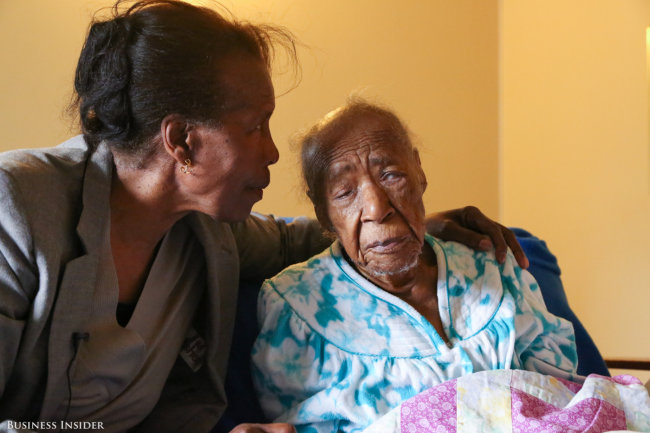
Susannah Mushatt Jones became the world's oldest person on Wednesday.
She has loved bacon for more than a century. Jones is 115 years old,
and the meat is the first thing to disappear from her plate every
morning. The eggs go next.
Last month, we arrived five minutes late for breakfast in Jones'
home, a sunbathed one-bedroom in the Vandalia Houses, a public-housing
facility for seniors in the Canarsie neighborhood on the southern edge
of Brooklyn, New York. She'd already dispensed with the bacon and was
tackling the grits. Jones is blind, and partially deaf, but with steady,
fervent hands, she searched her plate for morsels and shoveled them
into her mouth.
The routine is the same each day for Jones. When she finishes the
grits, she unwraps five sticks of Doublemint gum and tosses the papers
on the floor beside her slippers. She likes to chew them all at once
because, as her caretaker explained, "they're making them so flimsy
now." The oversize armchair engulfs her as she leans back to sleep.
As the oldest person in the world, Jones is one of two verified people remaining who were born in the 1800s. She's one of about 40 supercentenarians, or people who lived past their 110th birthday.
Her age has earned her something of a celebrity status. When we
entered her building, other residents spotted our cameras and
immediately asked if we were there to see Jones, or "Miss Susie" as
she's known among family and friends. A newspaper clipping about Jones
hangs in the lobby, and her room is decorated with cards she's received
from notable well-wishers over the years, including President Barack
Obama (whom she voted for in 2008), former New York City Mayor Michael
Bloomberg, and children from local schools.
While Jones' feats of longevity aren't entirely unparalleled (a
Frenchwoman once lived to be 122, the longest confirmed human lifespan
on record), her nearly perfect bill of health has amazed doctors and
family for more than a decade. We met with Jones and her niece, Lois
Judge, to find out what it takes to be a supercentenarian.
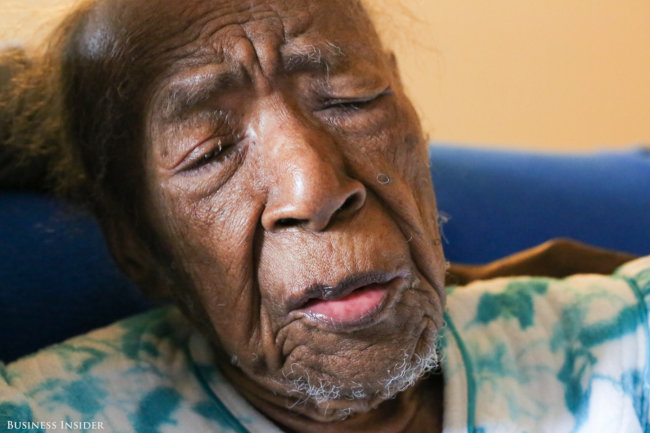
A long way from Lowndes County
Jones doesn't look a day over 100. The Lowndes County, Alabama,
native has smooth, soft skin, like peach fuzz. Patches of light brown
hair cover her head, while whiskers pepper her chin. Her frame is small —
maybe 5 foot, 90 pounds — a far cry from the sturdy woman she was in
her youth. Still, the most prominent giveaway of Jones' age is a cloudy
left eye. Glaucoma took her sight 15 years ago.
But the moment Cecily Freser, her live-in caretaker of more than 12
years, clears the breakfast plate from her lap, Jones nosedives into a
pillow resting on the recliner's arm. She sleeps most of the day, with
the radio or a daytime-TV game show playing in the background, though
she probably can't hear it. These days, Jones mainly responds to the
voices of her family members and friends.
"Sometimes she'll ask a question," Freser said, "and sometimes she'll
laugh to herself. She'll say, 'I was thinking about something someone
did long, long ago."
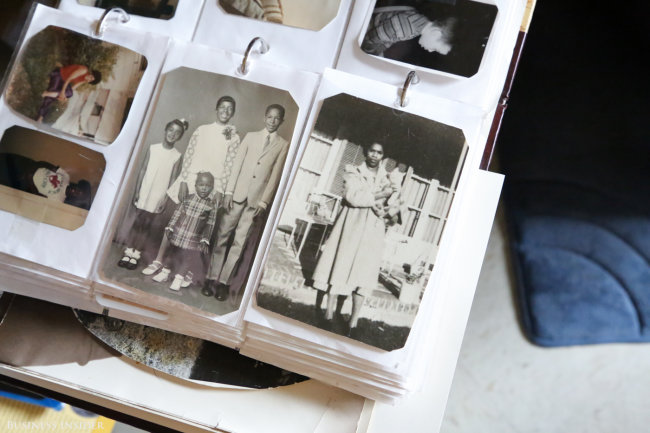
Born July 6, 1899, Jones grew up the third oldest of 11 children in
the Alabama countryside, about an hour southwest of Montgomery. Her
parents worked as sharecroppers. After graduating from high school in
1922 (she's kept the class roster over the years), she was accepted to
the Tuskegee Institute's teaching program. However, her family couldn't
afford to send her. A year later, she hopped a train to New York City.
Jones found work as a nanny for wealthy white families, and she
traveled the country with them, from New Jersey, Vermont, California,
and Mexico to Westchester, New York. Some of the children she helped
raise have stayed in touch with her family over the years and visited
her at the apartment in Brooklyn. Jones never had children of her own,
though she was married briefly to a man named Henry Jones, and took
great pride in the kin she cared for professionally. She roomed with the
families, and on days off, stayed with friends in an apartment at 145th
Street in Harlem, New York.
Throughout her life, Jones lived simply: no parties, smoking, or
alcohol. Her greatest indulgence was lace lingerie from Bloomingdale's,
with which she reportedly startled her doctors when she sported it during an EKG appointment years ago.
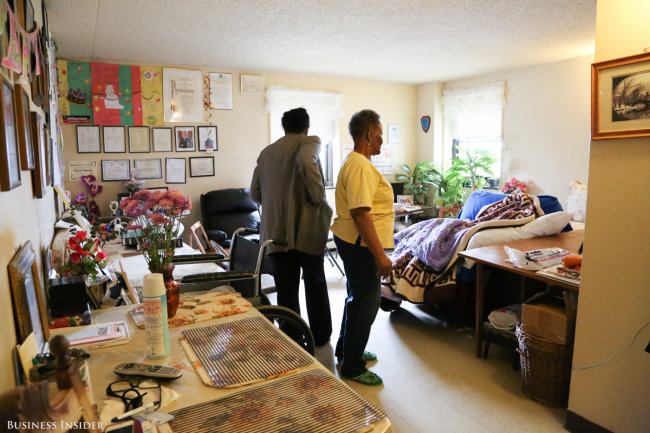
Jones had no trouble spending money on her family, however. At
Christmas, she gifted pill boxes of pennies, nickels, dimes, and
quarters to the young ones. She loved to bake cakes for company. And
Jones used her salary to send her nieces to college and to provide
scholarships for other Alabama students, so they would not be prevented
from attending college as she was.
Judge, her niece, still has the cashmere sweater adorned with pearls
that Jones sent her while she was away at school. Dressing well provided
a crucial source of pride for Jones, who grew up as an African-American
woman in the segregated South. She once returned to Alabama for the
funeral of a family member. When she stepped off the platform in
Calhoun, a predominantly white area, the bystanders gawked at her
outfit: a jacket, hat, gloves, and bag on her arm.
"They said, 'Who is this important person getting off the train?' She
felt so proud," Judge said, having heard her aunt tell the story over
and over. "But of course, who was there to pick her up but someone with a
wagon and a mule?"
In 1965, Jones joined the family at Mushatt Farms in Alabama, where
they raised cattle and horses, and stayed 10 years. She loved the
countryside and would have gladly lived out her 50-plus-year retirement
there. But as more relatives migrated north, her growing dependency on
them forced her to follow.
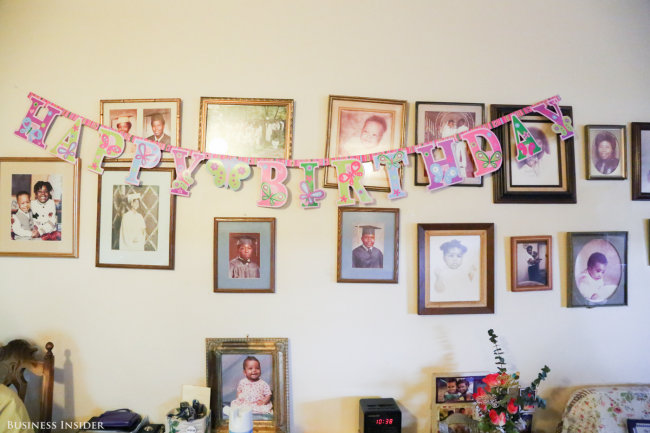
One in 7 million
Jones represents a very rare slice of the demographic pie. Supercentenarians occur at a rate of about one in 7 million people. In the US, roughly a dozen of every 4,500 centenarians, or people who reach the age of 100, will live past their 110th birthday.
A surprising majority, like Jones, are in great shape. According to the Boston School of Medicine-New England Centenarian Study, a leading center for longevity research, 69%
of supercentenarians show no signs of age-related diseases, such as
cancer, cardiovascular disease, dementia, and stroke, at age 100 or
later. Another study found 41%
of supercentenarians require minimal or no assistance in activities of
daily life, such as feeding, bathing, and getting in and out of bed.
Jones' daily regimen is simple. Every morning with a glass of water
and cranberry juice, she takes a multivitamin and a blood-pressure
medication. She sees the doctor just four times a year for
"maintenance," Judge said. Along with chewing gum and her breakfasts,
Judge said Jones' diet largely consists of fruits. She never complains
of pain. To the bewilderment of her physicians and family members, Jones
even appears to be "reverse aging." Over the last four years, her hair
changed from gray to brown and softened. When she was 96, she grew a
tooth — not a wisdom tooth, not an impacted tooth, but a new tooth — in
her lower jaw. She's a medical marvel.
For decades, researchers have engaged in a modern-day space race to
identify the common thread among supercentenarians that allows them to
live so healthily, so long. Jones checks off a few boxes.
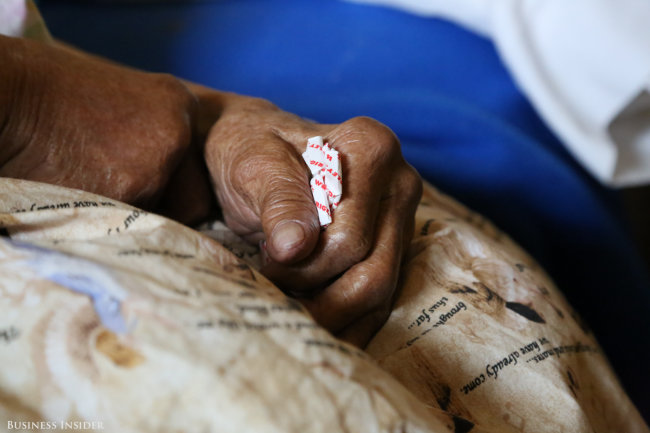
The genetic jackpot for long-lasting life
Jones is a woman, and that counts for something. About 90% of
supercentenarians are female. The New England Centenarian Study suggests
that women may biologically fare better than men when age-related diseases manifest, meaning they hold on longer despite illness.
In her heyday, she never abused alcohol or drugs. Even coffee was too strong for her tastes.
Most important, Jones has good genes. Her niece Judge told us that,
according to the US Census, Jones' grandmother lived to be 117.
The research is inconclusive, but it suggests that supercentenarians
have ingrained protective mechanisms — basically a complicated web of
genes — that help them avoid age-related diseases and delay cognitive
and functional decline.
George Church of Harvard Medical School explained it best in an interview with io9's George Dvorsky:
"To appreciate why it's so extremely rare
to live to 107 and beyond you need to think about it this way. It may
take several genes to help protect a person from various forms of
cancer. You can have all of those genes, but still die early of
cardiovascular disease. If you have genes that protect you from the many
forms of CVD, you may nevertheless still die early from cancer,
neurodegenerative diseases, diabetes, and so on. So a person likely needs numerous protective genes in every major category of disease risk, in order to sidestep these typical longevity landmines."
As researchers scramble to pinpoint the winning DNA combination, Jones sticks with her routine.
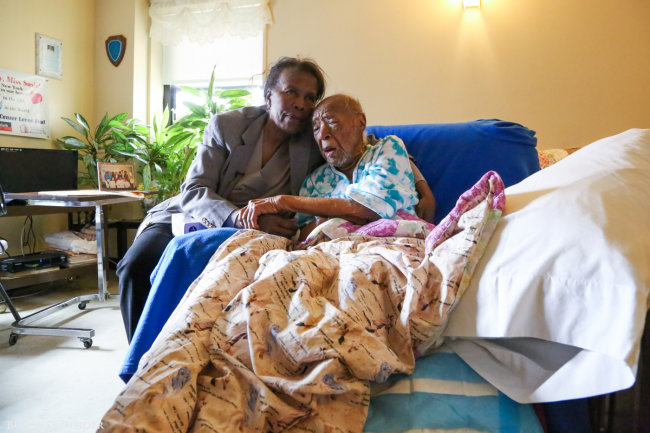
Strength in family
According to Judge, Jones partially attributed her longevity to
family. She never had children or a husband of her own, but she still
had a large family around her to provide comfort, contact, and a support
system.
For the past 30 years, Jones has lived in her apartment in the
Vandalia Houses. Her nieces and nephews visit every Sunday, and she will
call out any one of them who misses a week. Though she can't see them,
she recognizes their voices and the ways they interact with her; one
likes to tap her on the head, for instance. Judge knows it's possible
one of them will live to be 115 years old, although she hopes it's not
her.
"I don't think I would have the support that she has," Judge said. "She's had good people with her."
Still, the apartment doesn't feel like home to Jones. "She wants to
go back to Alabama, that's her main thing [these days]," Judge said,
quoting her aunt's refrain, "'I want to go home, I want to go home.'"
They try to remind her that the family no longer lives at the farm,
with seven Mushatts residing nearby. Brooklyn is her home now. Jones
will often reply, "'No, this is not what you call home."
Then she goes back to sleep, where her family likes to think she returns to Alabama.